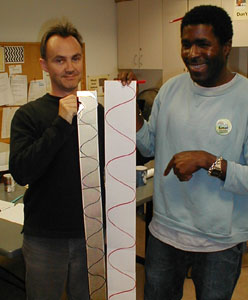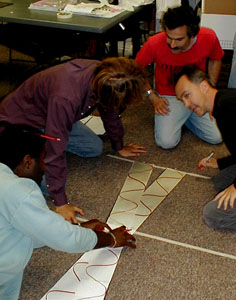Light travels like a wave
Introduction
In 1801 Thomas Young passed light through two
slits, A place that was bright with either slit alone became dark
when the light from two slits was added together so that light plus
light produced dark. This lead Young to propose a wave model for
light.
Here we will create a model of the two slit experiment.
Material
3x5 index cards at least 24
masking tape and transparent tape
Blue and black magic markers
optional, 4 x 6 cards and 5 x 7 cards
pens; red and green.
Assembly
Use a blue pen to draw a single sinewave on twenty-four 3x5 cards. The wave should start at the left center of the card and go up to a maximum.
![]()
Tape the cards together in rows of 8 cards.
Construction Hint: Very carefully draw the first sinewave on one card. Then place the subsequent cards one at a time on top of the first one and trace the pattern from the first card onto the other cards.

Make a model of two slits, place a strip of masking tape on the floor pull off some tape to create two slits about two "blue" wavelengths apart, that is 25 cm or 10 inches. Put a second masking tape strip about 2 meters long 5 "blue" wavelengths away (60 cm or 2 feet) and parallel to the first.

To Do and Notice
1. Start one strip of waves at the center of one slit, and a second strip at the center of the other slit. Stretch them out until they cross at the "screen," at a point halfway between the slits. Notice that both waves have the same phase at this point. Make a blue mark at this point.
2. Move the crossing point along the "screen" tape until the waves become out-of-phase. Here they will add together and cancel creating a dark place. Make a black mark at this point. (Draw a blue circle around the black mark.)
What’s Going On?
1. Both waves start out together with the same phase and travel the same distance to the center of the screen so they have the same phase when they add together. There is thus a bright spot in the middle of the screen.
2. One wave travels one-half a wavelength further than the other where they add together to produce darkness.
At other positions along the screen the waves add to produce intermediate values of brightness.
Going Further
Material
4x6 or 5x7 cards
green and red pens
Assembly
Use the green pen to draw waves on a chain of eight 4 x 6 cards.
Use the red pen to draw waves on two chains of eight 5 x 7 cards.
To Do and Notice
Repeat the experiment using the green and red wavelength waves. Notice the locations of the maxima and minima.
Math Root
Go to the exploration of the mathematics of interference.
Etc.
Feynman once said "all of quantum mechanics is contained in the
two slit experiment, unfortunately no one understands the two slit
experiment."
Teacher comments
Q "When one wave reaches the wall and it is maximum does it mean it is bright there? and when it reaches the wall at a zero crossing is it dark?"
A This model of interference is a still snapshot of the light wave which is actually moving at the speed of light, so at a place where the maximum arrives at the screen NOW in just a short time a zero crossing will arrive there then a minimum. So we cannot talk about light ever being still. It is the alternation of max-zero-min that makes light.
Q "Well then how is a dark spot ever created on the wall?"
A. At certain places on the wall two waves arrive and add together so that their sum is ALWAYS zero. There is no oscillation there and so no light.
|
Scientific Explorations with Paul Doherty |
|
24 May 2000 |